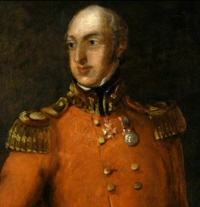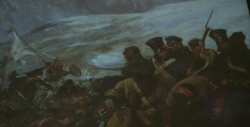The British Surrender
The Slaughter in the Jaws of Hell

General Elphinstone
Following the inevitable insurgency the British commander, General Elphinstone, tried to negotiate with the Afghans. The Afghans offered him safe
passage, provided the British handed over their heavy weapons and retreated immediately to India.
It must have felt like an impossible decision. If the garrison tried to stay, they could starve and be wiped out. But if they were to
retreat, could they really trust the assurances of their enemy?
I faced a similar dilemma on a smaller scale when I was a deputy governor in the south of Iraq after the invasion in 2004. Our compound was under
siege. We were being attacked by Sadarist militia, and their commander came to us and said that if we agreed to leave their weapons and hand ourselves
over to him, he would take this safely out of the fort and the back. At the time I thought it was a trick, a trick to massacre us, and I felt, again,
the same thing when I read this history.
In Iraq, we stayed and defended the compound, but the British in trouble, in 1841, were deeply divided. Many young officers were determined to
fight on, but Elphinstone overruled them and ordered a retreat. All the troops, their wives and children, were forced to leave the relative safety
of their compound, and to try and reach the British garrison in Jalalabad nine days march East of Kabul.
Jaws of Hell
They made painfully slow progress and after two days, this straggling column of soldiers and civilians met their fate beneath this mountain.
This valley is the Jaws of Hell. Into this, in midwinter, the cream of the British army marched and they were treated as though they were in
a slaughterhouse. By the time they reached this valley, Khord Kabul, they had spent two nights out in the open three-foot snow in temperatures of
minus 15 without tents, waking up to discover frozen corpses around them. They staggered into this valley, starving, frozen, with no supplies, and
80 miles to go, and it was at that point that the attack began.

William Dalrymple

A Few Survivors
Behind every boulder was an Afghan with a Musket taking careful aim, able to pick off, individually, 3000 people and kill them as they made
their way through the valley. And it continued, not just for one or 2 miles, but for 5 miles of a ravine. By the time they reach the end of
that valley, 90% of the British Army had been extinguished.
A handful of soldiers managed to fight their way through, but only to meet their fate later.
William Dalrymple “What we’ve got here is a last stand of the 44th foot at Gandamak. 50 men make it to the village of Gandamak. A stand on this
low hill and they have run out of ammunition, they’re relying only on their bayonets. And the picture we see here is half of them are dead and the
Pathans are about to close in and ended with their swords”
Of the 17,000 men, women and children who set out nine days earlier from Kabul, only one made it to the British garrison in Jalalabad. One man has
made it on from there, he is Dr Brydon.
William Dalrymple “In this picture, Dr Brydon is sitting on his old nag, about to collapse and he is seen limping towards Jalalabad, and the
assume he is only the first of thousands of troops to make it, and the gates opened and a party sent out. Realising the truth, that night, the
commanding officer orders the bugles to be sounded all night.”
The British Empire never had, and never would, experience a defeat like it.
Jihad Booty
William Dalrymple “The first Afghan war was a major event for the Afghans. We always see it through our perspective as a great imperial
disaster, but for the Afghans, this was their Trafalgar, their Battle of Britain, their Waterloo, all in one. They were the only non-colonial
power to see off a modern westernised Army in the 19th century, on the sort of magnificent scale that they did, and completely destroyed an
entire Victorian Army at the very peak of Britain’s power.”
For Afghans, this has confirmed that they were a warrior nation, one even capable of seeing off a great power like Britain, but Western
historians point to another legacy that resonates today.
Professor Thomas Barfield “The first time there is really a feeling of jihad inside Afghanistan is the first Anglo-Afghan war. After
that, it never really goes away. Beginning with the British invasions, Afghans begin to perceive themselves as fighting an outside
non-Muslim world. Now, they had known this before. When they raided India, that was jihad, you know. You got to go into infidel lands
and take home a lot of good stuff. But inside Afghanistan, you couldn’t do jihad. Now when these foreigners invaded, people would
say, yes, we’re fighting non-Muslims.”


